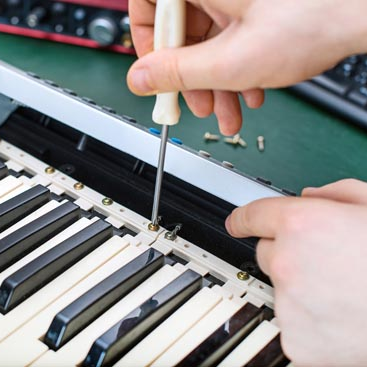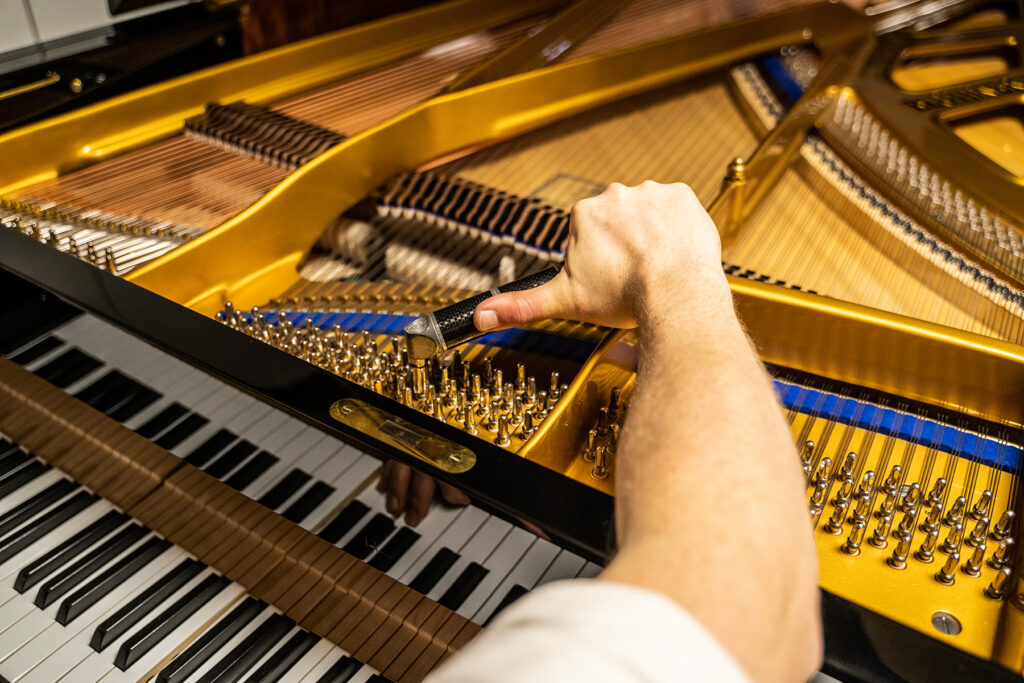Every piano has a voice—an expressive, rich, and dynamic tone that sets it apart. Whether you’re performing on a concert stage or playing in your living room in Austin or San Antonio, the quality of your piano tone can make a dramatic difference in how your music sounds and feels. While many focus on tuning, one of the most overlooked aspects of a piano’s sound is voicing. Understanding piano voicing and how to adjust it properly is essential for unlocking the true character of your instrument.
Understanding Piano Tone Beyond Just Tuning
Over time, piano hammers become compacted from repeated playing. This hardening leads to sharper, sometimes harsh tonal qualities, especially in higher registers. Through voicing, a skilled technician softens or reshapes the hammers to restore a balanced, expressive tone that matches your playing style and acoustic environment.
Many piano owners assume that tuning alone will make their instrument sound better. While tuning corrects the pitch of each string, it doesn’t address the overall character or texture of the sound. That’s where voicing comes in. Voicing a piano is the process of adjusting the hardness or density of the hammers to control how bright or mellow the piano tones are.
What Happens During Piano Voicing
Voicing a piano isn’t a one-size-fits-all process. It requires careful listening, observation, and sometimes artistry. A technician evaluates how each note sounds in comparison to the rest. Inconsistencies in volume, brightness, or tonal quality are addressed by modifying the felt hammers—either through needling to soften them or applying hardeners for more brightness.
The goal is to achieve uniformity in tone across the keyboard and ensure the sound suits the pianist’s musical needs. For instance, a jazz pianist in Austin might prefer a warmer, rounder tone, while a classical musician in San Antonio could look for more clarity and brightness for complex pieces.

When to Consider Piano Voicing
If you find yourself adjusting your playing to avoid harsh or uneven sounds—or if certain notes feel like they don’t “belong” with the rest—it may be time to get your piano voiced. Pianos that are played regularly, especially in schools, churches, or performance spaces, require more frequent voicing to maintain their quality. However, even home pianos benefit from periodic attention to ensure they retain a pleasing, even tone.
Changes in the acoustics of your space, the type of music you play, or simply your growing sensitivity as a musician can also prompt a need for voicing. If your piano was recently moved between Austin and San Antonio, it may sound different in its new setting, and voicing can help adapt it accordingly.
The Role of Climate and Use in Piano Tone
Texas weather can be tough on pianos. Humidity and temperature fluctuations in both Austin and San Antonio affect the felt hammers and wooden components of the instrument. These environmental factors can harden or soften hammer felt over time, altering how your piano sounds.
Additionally, how often and how hard a piano is played can significantly influence tone. Pianos in schools or music studios typically develop tonal inconsistencies faster than those in private homes. A skilled technician considers all of these variables when performing piano voicing to ensure the instrument not only sounds great but stays stable over time.
Personalizing Your Piano’s Voice
One of the most rewarding aspects of voicing is that it can be tailored to your personal preferences. Unlike tuning, which has a strict standard, piano tone is subjective. Some players desire a bright, crisp sound that cuts through a performance hall. Others want a mellow, delicate tone ideal for ballads or meditative compositions.
If your piano doesn’t inspire you the way it used to, voicing might be the answer—not a replacement. A well-voiced piano becomes a true extension of the pianist, responding to every nuance and intention in their performance.

Voicing vs Tuning: Know the Difference
Tuning and voicing are often confused, but they serve very different purposes. Tuning aligns each string to the correct pitch. It’s essential and should be done regularly, especially in fluctuating climates like those in Texas.
Voicing, however, shapes the piano tones themselves. A well-tuned piano with poor voicing can still sound unbalanced or uninspiring. Voicing brings out the emotional quality of the instrument, making your music more expressive and satisfying to play.
Why Choose Us for Piano Voicing in Austin and San Antonio
At TX Pianos, we understand the delicate relationship between a pianist and their instrument. Our team of expert technicians specializes in crafting tones that match each pianist’s unique playing style. We serve clients across Austin and San Antonio, offering in-home service with precision, care, and a commitment to quality.
Whether you’re a teacher, performer, student, or casual player, we take the time to understand your musical goals before adjusting your piano’s voice. With years of hands-on experience and deep knowledge of how climate and usage affect your piano tone, our voicing services help your instrument sing at its best.
How Often Should You Voice Your Piano?
There’s no set timeline, but most frequently played pianos benefit from voicing once a year. For home pianos, every 18–24 months may be sufficient depending on the conditions and frequency of use. If you’re unsure whether your piano needs voicing, we recommend scheduling a consultation.
Even small improvements in voicing can make a noticeable difference in how inspired you feel while playing. Regular care keeps your piano’s tone consistent, responsive, and enjoyable for years to come.
Adjusting Tone for Performance Spaces
If you’re a musician who performs publicly in Austin venues or churches in San Antonio, the tone of your piano becomes even more important. A piano that sounds amazing in a studio may not project well in a concert hall. Voicing can be used to adjust your instrument to suit different performance settings, allowing your music to reach every listener with clarity and warmth.
We’ve worked with countless musicians across Central Texas to voice their instruments not just for practice but for live performance impact. That’s the difference a truly professional touch brings to your musical journey.
Conclusion: Your Piano Deserves Its Best Voice
Your piano’s tone is a reflection of your musical identity. Whether it’s sounding too bright, too dull, or just inconsistent, voicing offers a powerful solution. It’s not just maintenance—it’s refinement. In a musically rich region like Austin and San Antonio, where performance and passion meet, your piano deserves to sound its best.
Let your instrument speak with clarity, warmth, and power. Voicing gives it that voice.
Contact us today to schedule your piano voicing session and experience the difference a perfectly adjusted tone can make.